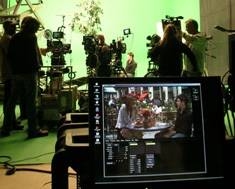Members of the MIT community have a history of transforming visual effects. Herbert Kalmus (1903) and MIT Physics Professor Daniel Comstock co-developed Technicolor (yes, it was named after MIT) in 1915 and Bill Warner ’80 created the Avid digital editing system.
And now Eliot Mack SM ’96 hopes to add his name to the list. His portable Previzion system enables accurate matching of live-action foregrounds and computer-generated backgrounds so directors can see beyond a green screen at how the final shot will look. Watch video of the technology in action.
While green-screen technology is not new (meteorologists swear by it), creating live photorealistic images with it is. Current technology has problems accounting for motion tracking, image resolution, focusing and defocusing background shots, and capturing lens adjustment calibrations, which are crucial for post-production work. Mack has refined his technology to automatically generate camera tracking data and to not miss a single strand of hair against the backdrop. “Essentially, we’re recreating the world on the fly,” he says. So far, it’s been used on the television show V, the upcoming Tim Burton movie Alice in Wonderland, and the Knight Rider made-for-TV movie.
Read the Slice of MIT blog post to learn how Mack's invention works.






